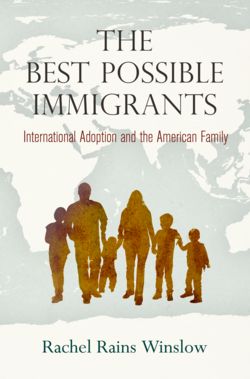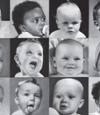FB 8
The Best Possible Immigrants: International Adoption
By: Rachel Rains Winslow
Audio Interview
Please listen here for the interview the author and her colleague, Heather Keaney. Visit the SHCY Podcast website for more episodes.
This review appeared in the Journal for the History of Childhood and Youth 11, no. 2 (Spring 2018): 277-279.
The Best Possible Immigrants: International Adoption and the American Family.
By Rachel Rains Winslow.
Philadelphia: University of Pennsylvania Press, 2017. x + 312 pp. Cloth $45, e-book $45.
Transnational adoption became established as a form of child mass migration in the mid-twentieth century and has grown significantly since then: demographer Peter Selman estimates the total number of adoptee migrants to be approximately one million worldwide. Rachel Rains Winslow’s monograph on the histories of some of these child migrants is timely, if not entirely focused on adoptees as immigrants. Winslow uses two of her six chapters to document domestic adoption policy within the United States’ first century of child welfare practice, beginning in the mid-1800s, and on the development of the American adoptive parent as a valorized figure in the mid-1900s. The remaining four chapters examine the histories of Greek transnational adoption to the United States following World War II, the beginning of Korean American transnational adoption after the Korean War, and Vietnamese American transnational adoption during and after the Vietnam War. Considering the theme of adoption in the aftermath of armed conflict that runs through her case studies, Winslow could have examined transnational adoption as a particular form of postwar and Cold War immigration—a line of inquiry that has been pursued by several Asian Americanists, including myself. Instead, Winslow has chosen to emphasize volunteerism as a powerful force working with, or instead of, state actors to initiate and expand overseas adoption schemes that have grown into today’s global adoption industry.
In addition to emphasizing American volunteerism, Winslow argues that four paradigms—sometimes competing and sometimes overlapping—have shaped domestic and transnational policy and practice from the end of World War II to the post–Vietnam War era. These are consumerism, representing the interests of American adoptive parents; child welfare, reflecting social workers’ investments in adoption outcomes; humanitarianism, representing the state’s interest in how it is perceived on the international stage; and development, emerging from  adoptee-sending nations’ interests in economic recovery in the aftermath of war. Though Winslow applies her multi-paradigm approach more convincingly in some instances than others, it is certainly a useful way to understand the complex interplay of converging and competing interests across the history of transnational adoption. In addition, Winslow connects US domestic and international adoption policy histories, shedding light on how large-scale US transnational adoption practice was allowed to be started by unprofessionalized organizations and individuals with literally no experience or training in child welfare.
adoptee-sending nations’ interests in economic recovery in the aftermath of war. Though Winslow applies her multi-paradigm approach more convincingly in some instances than others, it is certainly a useful way to understand the complex interplay of converging and competing interests across the history of transnational adoption. In addition, Winslow connects US domestic and international adoption policy histories, shedding light on how large-scale US transnational adoption practice was allowed to be started by unprofessionalized organizations and individuals with literally no experience or training in child welfare.
Transnational adoption scholarship is necessarily inter- and multidisciplinary. Winslow usefully pulls together adoption policy and culture as circular: one has great influence on the other. This is especially true in her examination of adoptive parent memoirs, through which white adoptive parents of the 1950s literally rewrote themselves as heroes, redefining a mode of family building that had hitherto been regarded as second class. However, Winslow’s unwill- ingness to incorporate secondary sources from disciplines other than history, where most of the work on transnational adoption culture and policy has been published, is a weakness of this volume.
Despite the book’s title, Winslow devotes very little attention to the discus- sion of transnational adoption within broader immigration debates and some- times fails to connect her detailed histories to the present, or even to immigration policies that were put in place after the historical periods covered in the book. For instance, although Winslow discusses the situation of mixed-race “GI babies” in both South Korea and Vietnam at length, she does not follow through to the passage of the Amerasian Act of 1982 and later laws that allowed people with Cambodian, Laotian, Korean, Thai, or Vietnamese mothers and American fathers entry into the United States, leading to the eventual immigration of tens of thousands of individuals and families. In addition, Winslow’s avoidance of the topic of war sometimes becomes confusing, especially in her chapter-long discussion of child welfare policy in Vietnam in the 1960s and 1970s, where she chooses to focus on the inability of American policy makers to understand the racial dynamics of Vietnam. While Winslow’s observations here are valid, to discuss this period of Vietnam’s history without contextualizing it within the Vietnam War seems shortsighted. And while her focus on volunteerism is productive, it would be even more so if she was able to develop a deeper critique of how the politics of volunteerism, religious and otherwise, have shaped the transnational adoption industry. The Best Possible Immigrants is much more about adoption than about immigration, but on the topic of transnational adop- tion, it is an engaging, well-written, and thoroughly researched study that will be of great interest to scholars of transnational or US domestic adoption and to scholars of Cold War American volunteerism and NGOs.
Kim Park Nelson
Minnesota State University at Moorhead
About Rachel Rains Winslow
Rachel Rains Winslow is Associate Professor of History at Westmont College, Director of Westmont’s Center for Social Entrepreneurship, and Co-Director of Westmont’s Initiative for Public Dialogue. She is the author of The Best Possible Immigrants: International Adoption and the American Family(University of Pennsylvania Press, 2017). Her current research explores the political culture of bureaucracy in the transnational United States throughout the nineteenth and twentieth centuries. Dr. Winslow also serves as a fellow with the Kettering Foundation, working on the intersection between historical deliberation and civic participation as a way to engage students in democracy. Her teaching, research, and community work bring together her interest in U.S. social policy, social change practices, and American political culture.
This post is part of the SHCY Featured Books series, in which SHCY members provide written contributions on various academic topics pertaining to the history of childhood and youth.




